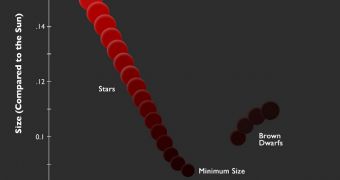A team of investigators from the Georgia State University announces in a new study the discovery of the limit separating very low mass stars from objects called brown dwarfs, which are in essence stars that failed to form properly.
Brown dwarfs resemble massive gas giants more than they do small stars. Experts have known about these objects for years, but have thus far found it difficult to determine the exact limit where a brown dwarf becomes a small star. The new work addresses this very issue.
Stars can come in a variety of shapes and sizes, from supermassive behemoths that make the Sun look like a pebble to very small dwarfs, which are only a fraction of our parent star's mass. Defining the lowest mass and temperature limit for a star has been the goal of many studies over the years.
The new research was conducted by the Research Consortium On Nearby Stars (RECONS) group at GSU, and is the first to discover clear evidences of the break between small stars and brown dwarfs. The data used in the study were collected by the Southern Astrophysical Research (SOAR) 4.1-meter (13.45-foot) telescope.
Additional information was collected with the Small and Moderate Aperture Research Telescope System (SMARTS) 0.9-meter (3-foot) instrument at the Cerro Tololo Inter-American Observatory (CTIO), in Chile. RECONS investigator Dr. Sergio Dieterich was the lead author of the study.
A paper detailing the findings has already been accepted for publication in an upcoming issue of the esteemed Astrophysical Journal. “In order to distinguish stars from brown dwarfs we measured the light from each object thought to lie close to the stellar/brown dwarf boundary,” Dieterich explains.
“We also carefully measured the distances to each object. We could then calculate their temperatures and radii using basic physical laws, and found the location of the smallest objects we observed,” he adds, quoted by Astrobiology Magazine.
“We see that radius decreases with decreasing temperature, as expected for stars, until we reach a temperature of about 2,100 K. There we see a gap with no objects, and then the radius starts to increase with decreasing temperature, as we expect for brown dwarfs,” the expert goes on to say.
Therefore, the smallest-possible star has a temperature of 2,100 Kelvin (1,826.85 ºC or 3,320.33 ºF). Any lower than this, and cosmic objects are cataloged as brown dwarfs, even if their radius is larger than that of very low mass stars.
A representative of this stellar group is 2MASS J0513-1403, which has a temperature of 2,100 Kelvin, a radius less than 9 percent that of the Sun, and a luminosity level 8,000 times lower than our star's.

 14 DAY TRIAL //
14 DAY TRIAL //